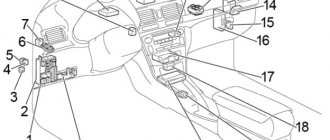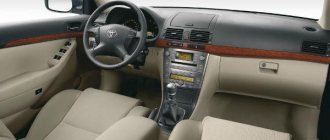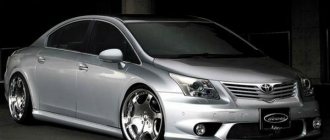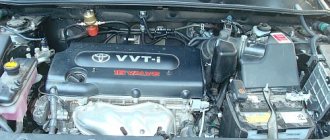Review of Toyota Avensis 2.0 16v VVT-i D4 (2006)
Quite recently I had the opportunity to be the proud owner of the legendary Japanese car Toyota Avensis. I won’t tell you how I got this car, I’ll just say that there was no choice, I just swapped cars with a friend: I gave him my Opel, and in return he got a Toyota... Now I’ve already swapped it for a Ford Mondeo, so this review is free or not. , but I will compare it with these two cars: Opel Astra Caravan Automatic 1.8 2010 and Ford Mondeo sedan Automatic 2.3 2009
I’ll note right away that the Avensis left a positive impression and, by and large, I didn’t experience any problems with it, I drove it comfortably, and if the car was younger, I most likely would have kept it for a longer time. Now closer to the topic of the review, what exactly is the 2006 Toyota Avensis? Automatic transmission, 2.0, in my subjective opinion, of course. Let's look at it in order:
1. Engine and gearbox
On the good side, this car could use a more powerful engine, in my opinion the 2.0 is too small, but there is a 2.4 in the lineup, where it most likely drives more fun, and there are some “vegetable” notes when driving. In general, driving an Avensis is a measured ride without sudden acceleration, this is suitable for calm people and preferably above average age. The younger generation will most likely be bored driving this car. It accelerates smoothly, but at the same time quite quickly reaches the permitted speed limit. It doesn’t eat oil, well, if only a little bit (at 3000 km about 0.4 l). The gearbox is a regular four-speed, with the ability to manually switch in the so-called sport mode; there is also a winter mode, activated by a button. Why did I call the sport mode “so-called”? Yes, because in the same Opel, when you press the “sport” button, a mode was activated in which the car actually drove differently, but here the box simply drops one gear and that’s it. Comparing the engine of Toyota and Ford is not entirely correct, since Ford uses all its 160 horses and, when accelerating, gives that unforgettable feeling for which people buy cars with more or less powerful engines. In general, there is comfort when driving an Avensis, and this is important. Consumption in average mode remained around 8 liters, you will agree that this is very little.
2. Suspension and ride quality
Avensis is quite soft when moving, and good sound insulation allows you to have fun during long trips. It is very difficult to break through the suspension, only if you really fly your wheel into a hole at speed. During the time I was using it, I did not change anything on the suspension, moreover, when checking at the service center, it turned out that almost all the parts were original, and this is very good, since the car is already 8 years. The car holds the road very confidently, which has been confirmed more than once on the difficult serpentines of the Black Sea coast. Driving around in the Avensis is very comfortable, and if you don’t go off-road, then it copes well with other roads. Various safety systems in the form of directional stability and anti-skid help you feel more confident in difficult conditions.
3. Interior, exterior and other little things...
The Toyota salon does not shine with various newfangled “cosmic” bells and whistles; rather, it is a kind of “homey” comfort in which you very quickly get used to it and feel at home. The equipment was rich, especially considering the year of manufacture. The dual-zone climate works well, cooling and heating the cabin when needed, the rain sensor is quite adequate, and the cruise has always been an added bonus for me on long trips. Well, I won’t mention all kinds of heating, since this thing is already present on almost all cars)) The trunk is rather large than small, although I never fully loaded it. The appearance is an amateur, of course, but I always liked it
In general, it may seem that this car has no disadvantages, but this is still not the case... The most important disadvantage is the very small battery, and this is a whole problem, I’ll tell you: you need to drive almost every day so that it is charged properly, otherwise there is a chance it won’t work. start the engine in the morning. This happened to me a couple of times, which made me very upset.))
My general opinion: a very decent car, which will take you to different points comfortably, and is not very capricious in maintenance.
2020-01-06 Second hands: Toyota Avensis second generation (2003-2009)
Buying a Toyota for 500-550 thousand rubles...Is it impossible? If you forget about the Land Cruiser SUV, RAV4 crossover and Camry sedan
, then for this money you can take a closer look at the second generation Avensis.
Moreover, in this case, not only an Avensis with a sedan body, but also a roomy station wagon can be considered as a candidate for purchase. The first generation of Toyota Avensis
debuted more than 20 years ago and replaced the iconic Carina E model. After that, two more generations of Avensis saw the light, but since the demand for D-class sedans in the European market over the last decade has decreased almost significantly, the Japanese decided that the third generation sedan will not have an heir.
The latter is not very widely represented on the secondary market also because Avensis left our market back in 2012, having completely lost the fight for the buyer of the larger Camry model. “ second” Avensis
, which was produced from 2003 to 2009, is, on the contrary, quite common on the secondary market. And no wonder: at one time this car sold well new.
Considering its advanced age, an Avensis produced in 2003-2004 can be bought for only 300-350 thousand rubles. If we consider sedans and station wagons from 2007-2008 with relatively low mileage, then you will have to be prepared to part with an amount of 700-750 thousand rubles. The vast majority of cars presented on the secondary market have a sedan body. However, with due diligence, you can find both station wagons and hatchbacks. The latter were not officially supplied to us and were probably imported from Western Europe already being used. There are no complaints about the build quality, provided it has an accident-free history. This is also true for the corrosion resistance of the body. But Avensis owners regularly complain about a white coating on the door frames. Moreover, such complaints were often expressed even by owners of practically new cars. There are also plenty of complaints about dimming headlight covers. The last problem, however, is typical for almost all modern cars. On the other hand, the Avensis boasts a tough paint finish that the older Camry sedan can only dream of. The Avensis salon no longer seems modern. Its age is revealed by the standard radio, which can play not only discs, but also cassettes. Changing the radio will not be difficult, but it is unlikely that unless absolutely necessary, it is worth interfering with Toyota’s electronics, which turned out to be very reliable. One of the few problems that appear with age is wear of the contact group in the steering column. Because of this, the buttons located on the steering wheel refuse to work.
Less serious problems include abrasion-prone seat upholstery. So in the case of the second generation Avensis, worn out seats are not a clear sign of high mileage. The Avensis was not spared from the squeaks of the interior plastic. Extraneous sounds are especially noticeable against the background of good sound insulation for D-class cars. By the way, on Avensis released after the 2006 update, sound insulation will be slightly better. Thanks to the additional soundproofing mats and new door seals. A more serious problem is a weak air conditioning compressor. While Avensis was under warranty, official dealers had to change compressors with enviable regularity. It is believed that the Japanese were never able to make this unit more reliable. When examining the specimen you like, you should definitely evaluate the performance of the air conditioner. When inspecting the engine compartment, you should pay attention to the condition of the side radiator tank. It is made of plastic and will crack over time. It is impossible to repair it. If something happens, you will have to buy a new radiator assembly. Unfortunately, there are a lot of questions about the power units installed on the Avensis. The 1ZZ series motors turned out to be not very reliable. The 1.8-liter engine causes the most problems. Toyota engineers seated the oil scraper rings very tightly, which is why they quickly lose their mobility. Often this happened after a run of 50 thousand kilometers. As soon as the rings begin to stick, oil consumption for waste increases many times over a short period. There are cases when a 1.8-liter engine consumed several liters of lubricant per thousand kilometers traveled. Naturally, it is impossible to operate a car with such a huge oil appetite. It’s worse if a critically low oil level cannot be noticed in time. The aluminum block is officially considered unrepairable, so it’s better to immediately start looking for a contract engine. Toyota was able to solve the problem with 1ZZ engines only by 2005. Upgraded engines do not cause problems. But it is important to understand that Avensis 2005-2006 can be equipped with both new and old engines. The easiest way to identify a modified engine is by looking at the oil dipstick: it should have a clearly visible green mark. It’s a pity, but you won’t have to calm down on this either. When inspecting a 1.8-liter engine, be sure to make sure there are no traces of antifreeze on the wall of the cylinder block
located closer to the engine shield.
If there are any, then the joint between the head and the cylinder block is no longer sealed from overheating. The company service will offer a complete replacement of the motor, but the masters of the club workshops will easily undertake the restoration of threaded connections for new head bolts. Given the problems of the 1.8-liter engine, it is not surprising that buyers prefer the Avensis with a 2-liter gasoline engine. The atmospheric unit of the 1AZ series is considered indestructible. You only have to keep your eyes open with direct fuel injection, which does not digest low-quality gasoline. A few refills with a surrogate are enough for expensive injection pumps and injectors to fail. If you refuel exclusively with high-quality fuel, the high-pressure pump will withstand 200 thousand kilometers without any problems. In case of overheating, the thread for fastening the cylinder head
will not hold up even on a 2-liter engine. However, after 2007, this power unit received a modified unit, which solved the problem. At the same time, the engineers did nothing with the delicate rear crankshaft oil seal. Otherwise there are no complaints. A mileage of 300 thousand kilometers for a 2-liter engine is far from the limit. In return, the Toyota engine will require maintenance every 10 thousand kilometers and manual valve adjustment every 150 thousand kilometers.
The top-end unit for the Avensis model was considered to be a 2.4-liter engine. This power unit also turned out to be demanding on fuel quality, as well as on the quality and timing of oil changes.
.
Those who want to save on oil services will very soon have to fork out for a new VVT-i system coupling. Uneven operation and knocking noises on a cold engine will indicate the need for its immediate replacement. Problems with starting the engine are also possible. A crankcase ventilation system that quickly becomes overgrown with deposits is a typical problem for Toyota Avensis. As soon as the ventilation system stops performing its functions, the engine will begin to sweat oil. A 1.6-liter turbodiesel engine is considered exotic in our market. There is no point in contacting her. Modern diesel engines are very demanding on fuel quality, and the parts of their fuel system are very expensive. In the future, savings on fuel will be completely wiped out by expensive repairs. Toyota recommends oil service for a 5-speed manual transmission every 40 thousand kilometers. However, almost all Avensis owners ignored this advice. A problem that appears with age is souring drive cables. Difficult and unclear switching of the “mechanics” lever will indicate the need to replace the drive. Frequent oil changes
- every 30-40 thousand kilometers - are also required for the Avensis automatic transmission.
In this case, its resource will be at least 250 thousand kilometers. Moreover, there are many cases where the automatic transmission on an Avensis lasted all 500 thousand kilometers. The fact that the box will need immediate repairs will be indicated not by jolts and jerks during switching, but by the oil quickly darkening after changing. Car enthusiasts make up legends about the reliability of Toyota suspensions. suspension
endures all the hardships of our roads Even bushings and anti-roll bars on Avensis often last more than 50 thousand kilometers. Most often, a serious suspension overhaul is required only after a mileage of 120-140 thousand kilometers. The only thing I can criticize a little is the rear suspension on the pre-restyling Avensis. It may begin to rumble due to unsuccessful silent blocks of the levers. However, given the age of this model, the previous owners probably installed the parts of the new model long ago. By the way, the rear suspension on a Japanese car is considered to be steering. Because of this, the Avensis did not drive any more excitingly, but the suspension design became more complex. For example, there are transverse links and ball joints not only in the front, but also in the rear. Surprisingly, the steering mechanism did not impair the reliability of the rear suspension at all. The owners can only monitor the mobility of the hinges. Otherwise, during repairs, the soured parts will have to be cut down. On cars with a 1.8-liter engine, the weak point in the steering mechanism is the steering shaft. Play in the spline joints is the cause of the knocking noise coming from under the hood. However, everything is limited to rattling when driving over bumps. If you don’t want to listen to extraneous sounds, you can turn to specialized professionals who can overcome the chatter. It will not be possible to deal with rack leakage on versions with classic power steering as quickly and cheaply. Only after the Avensis restyling did this problem begin to appear less frequently. Regularly lubricating the front caliper guides with thick grease is a must for those Avensis owners who want to get rid of the rattling of the calipers. Otherwise, there are no complaints about the braking system. A Toyota Avensis with a confirmed mileage of 200-250 thousand kilometers can be fully recommended for purchase. Such specimens are capable of traveling for quite a long time without major investments. It's even better if you can find an Avensis from the first or second owners. In fact, this is not so difficult, since our car enthusiasts prefer not to part with Toyota cars for as long as possible. On the other hand, the notorious “Toyota” reliability allows you to practically not monitor the condition of the car for a very long time. If you come across such a copy, the Avensis may seriously disappoint. And then the next car for the disappointed owner will probably be a new Renault Logan or Lada Vesta, which can be bought for almost the same money.
A technical inspection will be required.
, buy spare parts for Toyota,
repairs , maintenance, pick up a compulsory motor liability insurance policy
for Toyota Avensis in Kazan - we are waiting on the
Avto . tatar









